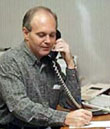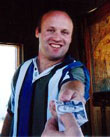|
|
 
|
|
Author
|
Topic: Digital I/O for 35mm VFX/Drive-In Film Restoration
|
Tim Reed
Better Projection Pays

Posts: 5246
From: Northampton, PA
Registered: Sep 1999
|
 posted 08-05-2000 10:54 AM
posted 08-05-2000 10:54 AM




I'm considering digitally restoring some of my rare drive-in intermission clocks; and offering pristine, 35mm Dolby SR prints for sale. (No copyright issues.) Note: there is another fellow who's attempting a similar project by making prints of prints--I'm not him. I'm talking a computerized-visual-effects-style restoration, as appears to be the latest 35mm technology; complete color correction, jitter and scratch removal, even (maybe) title and text changes to reflect current drive-in theatre requirements... anything's possible once it's scanned into the digital domain.The only fly in the ointment is this: the prices to have my film scanned, and then have the resulting file (after editing and computer manipulation) output back to 35mm, are EXHORBITANT!!!! I mean, take the highest price you can ever imagine, and then TRIPLE it... HIIIIIIIIIIIIIGH! That's Hollywood for you ($80 for a camera adapter screw... come on!) I have an investor interested in financing such an endeavor, but the lab scanning prices are beyond anyone's reach and, quite frankly, it wouldn't make the project feasible. The best I can hope for is a sale of maybe 50 prints, and having a brand new restored negative for posterity. Therefore, I'm seriously considering building my own scanner and maybe a recorder (although I can get this done commercially much more cost-effectively than the scanning). I'm looking at adapting a regular slide or 35mm negative still scanner to a pin-registered intermittent movement, and slap some reel arms on it, so I can get my film frames into the computer. The scanning resolutions available on some of the still scanners I've seen are identical to the motion picture units they charge $10,000s to use. Anyone have any experience with these things, or know about the scanning technology, or where I could learn about it? Also, what's a good way to generate Left-Right stereo components, from a sweetened mono track; and still keep voice frequencies on L and R equally (or nearly so)? ------------------
Better Projection Pays!
| IP: Logged
|
|
|
|
Chris Erwin
Expert Film Handler

Posts: 195
From: Olive Hill,KY
Registered: Oct 1999
|
 posted 08-06-2000 12:25 PM
posted 08-06-2000 12:25 PM




Tim,If only I had the money and talent to help! I know just a little from what's in that collection from the video tapes and WOW! ...to get my hands on some new prints! To jazz up a signal for extra "kick", I use a Behringer audio exiter/enhancer, which can deliver bass and trebble increases to the extreme. It can do wonders. A friend that played live music introduced me to it and gave me tips on set-up. On the scanning,I used one of those scanners once to save negatives on video. It had a postive/negative button, and I'd set it on negtive and scan so the image on TV was positive. With a few adjustments,I hope something like that works for you. Best of luck!
--Chris
| IP: Logged
|
|
|
|
William Hooper
Phenomenal Film Handler
Posts: 1879
From: Mobile, AL USA
Registered: Jun 99
|
 posted 08-07-2000 12:54 AM
posted 08-07-2000 12:54 AM





>What else can you tell me about that
>exciter? Can it bandsplit the audio into
>different channels? *Most* of Behringer's stuff will probably be in a rack for your examination & experimentation at the local rock'n'roll/drums'n'guitar music store. Aphex's has always been nice, without being obtrusive.
| IP: Logged
|
|
Oscar Neundorfer
Master Film Handler

Posts: 275
From: Senoia, GA
Registered: May 2000
|
 posted 08-07-2000 07:03 AM
posted 08-07-2000 07:03 AM





Tim,I have a couple of the Polaroid 35mm scanners, and they do a gorgeous job of producing a high-res scan either from positive or negative stock. HOWEVER, the files sizes of the scanned images are big, and you will definitely need LOTS of hard disk or other storage space to store all these scans. Unless I am doing the math wrong, a 30 second clip will cost you several gigabytes of space. I just scanned in a frame of test tone film to get an idea of file sizes. At 2700 dots per inch, and saving the file as a tif file, the uncompressed file size was around 30 MB. The LZW compressed tif file size was around 6 MB, but bear in mind that this image (having a lot of clear image area) was a highly compressible file. More complex images will not compress nearly this much. I suppose if you do a few frames at a time, and then output these frames to a film recorder, you won't have too many problems with disk space. However, you probably want to have a cd burner handy to archive the frames so you can free up the hard disk space for the next few frames. I may be telling you things you already know, so if I am please forgive me. Best of luck in this project. I think it is a great idea! ------------------
Oscar Neundorfer
Chief Engineer
SMART Devices, Inc. oscar@smartdev.com
| IP: Logged
|
|
Oscar Neundorfer
Master Film Handler

Posts: 275
From: Senoia, GA
Registered: May 2000
|
 posted 08-07-2000 07:09 AM
posted 08-07-2000 07:09 AM





Tim,I am not sure if I could do this, but I may be able to help you with the audio track on these films. I have SR encoding capabilities here as well as enhancement devices for turning mono tracks into pseudo-stereo tracks and other processing. Unfortunately I don't have any means of time locking (SMPTE Time Code, for example) but there may be ways around it. I am not exactly into audio post production techniques, but maybe I could help in some way if you like. Let me know if you would like assistance in this area. ------------------
Oscar Neundorfer
Chief Engineer
SMART Devices, Inc. oscar@smartdev.com
| IP: Logged
|
|
Bill Carter
Expert Film Handler

Posts: 162
From: Minneapolis, Minnesota
Registered: Sep 1999
|
 posted 08-07-2000 11:22 AM
posted 08-07-2000 11:22 AM




In order to scan at full aperture 35mm quality, your digital images should have the dimension 4096 x 3112. This is also the correct dimension for the laser film recorder that writes your image back to film.My company has already developed a scanning solution, and might be able to provide that service to you more reasonably than you think. We might be able to work out something that is within your reach. I can assure you that high-quality results require much more than slapping reel arms on a still scanner and running the film through. Our patented developments in optics have taken years and many dollars to create. When you start trying to capture resolutions this high and expect to later project them on the big screen, there's considerably more to it than you realize. The biggest and most inflexible cost seems to be getting the images back to film at full resolution. We don't offer that service. Commercial post houses offering these services get around $2.50 per frame, plus setup charges. Then, of course, you'd have additional expenses in reprinting the soundtracks. You are welcome to email me privately, if you'd like to get into more detail. Bill Carter
Image Premastering Services, Ltd.
St. Paul, Minnesota
| IP: Logged
|
|
John Pytlak
Film God

Posts: 9987
From: Rochester, NY 14650-1922
Registered: Jan 2000
|
 posted 08-08-2000 06:02 AM
posted 08-08-2000 06:02 AM





Most of the drive-in snack bar / policy trailers I remember were simple animation, without a lot of detail. So it may be possible to scan and output them at fairly low resolution, and still have acceptable results. A 2K scan on a Spirit Datacine will cost much less than a 4K scan, and you'll have less data to store and manipulate. The diffuse illumination and CCD scanning system that Kodak developed for the Spirit is also very forgiving of minor surface defects like scratches and abrasion, to the extent that a "wet gate" is not needed.AFAIK, the transfers of films for the Digital Cinema demonstrations were done at only 2K resolution, which still exceeds the display capability of the current DLP projectors. For more information on Kodak CineSite and its digital scanning / recording capabilities, see the CineSite website:
http://www.cinesite.com/la/la-scanrec.html ------------------
John P. Pytlak, Senior Technical Specialist
Worldwide Technical Services, Entertainment Imaging
Eastman Kodak Company
Research Labs, Building 69, Room 7419
Rochester, New York, 14650-1922 USA
Tel: 716-477-5325 Fax: 716-722-7243
E-Mail: john.pytlak@kodak.com
| IP: Logged
|
|
Tim Reed
Better Projection Pays

Posts: 5246
From: Northampton, PA
Registered: Sep 1999
|
 posted 08-08-2000 10:51 AM
posted 08-08-2000 10:51 AM




I was hoping to take advantage of that. There are many films that only require the restoration of just one good frame, or a handful of frames, repeated.Also, I would only need to occupy the relatively small dimensions of the 1.85:1 image area, since no one will see the top and bottom. That will help. I am eyeing my first 53 GB a/v drive, which can be daisy-chained with other units, up to several terabytes capacity. Thanks for all the great tips, fellows! I'll follow-up on your leads. You've really been a big help! ------------------
Better Projection Pays!
| IP: Logged
|
|
|
|
Chris Erwin
Expert Film Handler

Posts: 195
From: Olive Hill,KY
Registered: Oct 1999
|
 posted 08-08-2000 01:53 PM
posted 08-08-2000 01:53 PM




Tim,On the exciter, it goes beyond your EQ to give you crisp highs and deep bass. It can take a signal and add depth to it. I don't think it could help seperate the channels but it could help in customizing the sound before mastering. As someone else said,you can find 'em at most music shops that sell PA/recording gear. It's a cool gizmo. --Chris
| IP: Logged
|
|
|
|
|
|
Tim Reed
Better Projection Pays

Posts: 5246
From: Northampton, PA
Registered: Sep 1999
|
 posted 08-08-2000 06:46 PM
posted 08-08-2000 06:46 PM




Thanks Chris, Gordon, I appreciate the help and will check into that.. good ideas!Dave, Derek Maxwell is doing just what you describe. Talk to him. Brad, hang onto that trailer, we'll get it done right. Right now, it looks like we're going to make a short test. A successful test will likely greenlight more films. Of course, this all depends on whether or not there's enough of a market to make a return on the investor's money. We'll see. ------------------
Better Projection Pays!
| IP: Logged
|
|
|
|
All times are Central (GMT -6:00)
|
|
Powered by Infopop Corporation
UBB.classicTM
6.3.1.2
The Film-Tech Forums are designed for various members related to the cinema industry to express their opinions, viewpoints and testimonials on various products, services and events based upon speculation, personal knowledge and factual information through use, therefore all views represented here allow no liability upon the publishers of this web site and the owners of said views assume no liability for any ill will resulting from these postings. The posts made here are for educational as well as entertainment purposes and as such anyone viewing this portion of the website must accept these views as statements of the author of that opinion
and agrees to release the authors from any and all liability.
|

 Home
Home
 Products
Products
 Store
Store
 Forum
Forum
 Warehouse
Warehouse
 Contact Us
Contact Us




 Printer-friendly view of this topic
Printer-friendly view of this topic


















